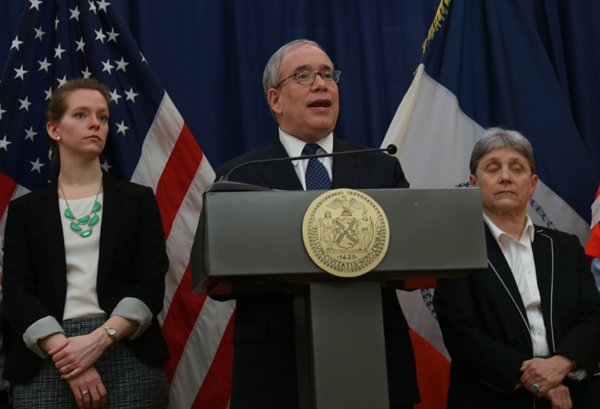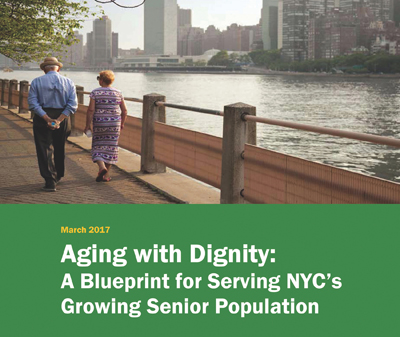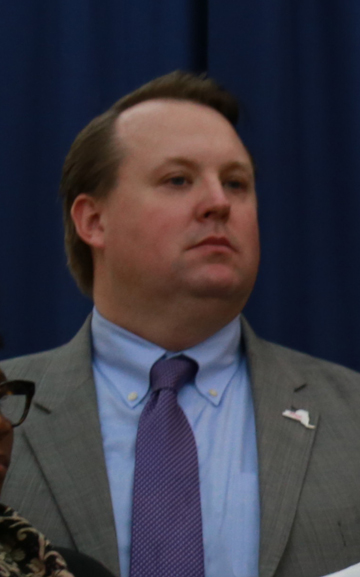
BY JACKSON CHEN | In an effort to address the needs of a surging senior population, City Comptroller Scott Stringer has released a blueprint of policies for ensuring their welfare and supporting the work of those who provide care for them.
At a March 21 press conference at the Greenwich House Senior Center at Washington Square, Stringer unveiled a new report, “Aging with Dignity: A Blueprint for Serving NYC’s Growing Senior Population,” that calls on the city to examine where neighborhoods housing seniors and agencies serving them could be buttressed.
“We need to act today — not tomorrow,” Stringer said. “Seniors are the anchors of our communities, and we must ensure they have the support they deserve.”
According to Stringer’s report, the city senior population rose 19 percent over the past decade from about 947,000 in 2005 to 1.13 million in 2015, representing about 13 percent of New York’s total population. The number of those 65 and older is expected to hit 1.4 million by 2020.
Borough-wide, 14.6 percent of Manhattanites were 65 and older as of 2015. Only Staten Island, at 15 percent, exceeded that concentration of seniors.
The Upper West Side’s Community Board 7 coverage area is home to more than 37,000 seniors, while the Upper East Side’s Community Board 8 district has nearly 43,000 seniors. Those are among the highest tallies in the city, with several community boards representing Queens neighborhoods being the only others with senior populations exceeding 30,000.

But as the city’s senior population rises, their overall support seems to be dropping according to Stringer’s report — a serious concern given that more than 40 percent of seniors depend on government programs for half of their income and that 60 percent of them spend more than 30 percent of their income on rent.
For groups working on issues involving seniors, the trends Stringer’s report laid out are not surprising but they do increasingly merit prompt attention.
“The trend of aging will not go away until that last boomer turns 65,” said Chris Widelo, AARP’s associate state director for New York. “And people are living much longer, healthier lives. We see it right now as a crisis on the horizon.”
Stringer’s report laid out a three-pronged approach to address the most important challenges, focused on affordable housing, senior-friendly communities, and supportive services.
Looking at affordable housing for seniors, the comptroller’s report recommended that the city automatically enroll eligible New Yorkers in the Senior Citizens Rent Increase Exemption program that provides a rent freeze for those 62 and older whose household income is $50,000 or less. The report predicted that automatic enrollment would capture 26,000 beneficiaries not currently enjoying the rental assistance.
For those who own, the report recommends expanding the Senior Citizens Homeowner’s Exemption, which grants a property tax exemption to those 65 and older, by raising the maximum household income from $37,399 to a $50,000 threshold.
Stringer also urged the city to create a program that would offer more incentives for seniors or their landlords to install safety measures like widened doors, grab bars in bathrooms, and no-slip surfaces.
The comptroller’s report endorsed expanding “Age-Friendly Neighborhood” programs across the city, as well. Launched in 2010, the initiative aims to draw on input from local seniors to enhance services, safety, transportation, business discounts, and other benefits available to those 65 and older. Currently, only 12 of the city’s 51 Council districts have such programs, but that list includes Manhattan Districts 6, 8, and 9, which together cover the portions of the Upper West Side and Morningside Heights, as well as East and Central Harlem.

Separate from that program, the report also calls for an overall strengthening in the city’s senior center network and a range of transportation improvements from bus shelters and benches to subway accessibility upgrades.
And to help those who care for seniors, Stringer is also calling for more funding for the Department for the Aging (DFTA) as well as for non-profit senior service providers throughout the city. The comptroller hopes that additional funding would eliminate the waitlist of 750 seniors currently looking for homecare and the 1,700 still looking for social services case management.
Stringer’s report acknowledged that his recommendations would involve additional cost — unspecified in the report — but asserted, “The cost of inaction would mean more seniors living in dangerous and unsafe conditions, and greater long-term strains on city programs as a result of higher demands for service.”
Widelo and other senior advocates were on hand with Stringer to voice support for solutions to problems they said have gone unaddressed for years. Just to return senior programs like Meals on Wheels to a stable footing, Widelo said, about $15 million would be needed, and he recommended another $44 million on top of that to give senior services momentum to tackle the growing needs.
However, Widelo said, the problem is more than just money.
“It’s not necessarily something you can throw money at, but I think we know there are certain problems that aren’t adequately funded,” he argued.
Support from the federal government is a particularly worrisome topic for those who work with seniors. The fate of the Affordable Care Act, for example, remains in limbo despite the Trump administration’s first-round failure at eliminating President Barack Obama’s signature legislative achievement, and healthcare is just one area threatened by potential cuts.
Bobbie Sackman, the associate executive director of public policy for LiveON NY, a group that does both advocacy work and program development, worries that senior access to healthcare and affordable housing in the city is at risk.
“There’s a war on old people in Washington,” she said, pointing out that seniors are part of every community and demographic group within the city. “Aging needs to be looked at as a women’s issue, an immigrant’s issue, an affordable housing issue, because seniors can often get siloed out.”
In line with that perspective, Stringer, on April 2, drew attention to an online survey that SAGE — Services and Advocacy for GLBT Elders — and the Stonewall Community Development Corporation are currently conducting to assess the needs of LGBTQ New Yorkers 50 and older.
Sackman warned that the reliance New York seniors have on the city’s Department for the Aging poses another risk given that the agency, in her words, is “limping into a bad economic time.” If funding sources tighten up further, the department could go from limping to crawling, she said.
Sackman’s view of DFTA was echoed by Nora Moran, a policy analyst with United Neighborhood Houses of NY, a coalition of 38 settlement houses and community centers.
“Older adults are the fastest growing population in New York City, yet services from the Department for the Aging remain underfunded,” she said. “It is time for New York City to take leadership over this issue and support older adults so they can age in their own neighborhoods.”
“When you get to a certain age, you’re invisible and don’t matter anymore,” Sackman said of the experience too many seniors face in the city. “Where are the resources? In many cases, it’ll end up with seniors getting hurt.”
The LiveON NY official acknowledged that the city has a robust infrastructure of services and service providers, but that the system is in urgent need of greater support. For her, Stringer’s report spells out how the senior services sector can be restored to a healthy position.
“We’re trying to get the word out,” Sackman said. “Don’t leave seniors aside and invisible in this because it’ll be to their detriment — and to the city’s detriment, as well.”

















